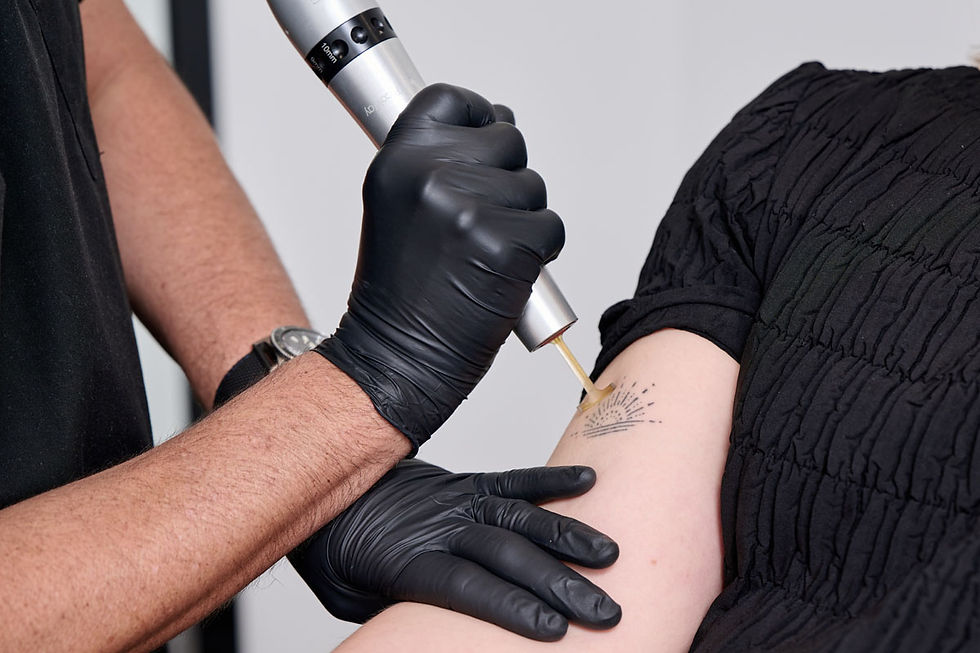Laser Tattoo Removal Ink Removal Experts
- danyalmalikdynamic
- Aug 29, 2024
- 4 min read
Tattoos have become a ubiquitous form of personal expression, yet many individuals find themselves seeking removal for various reasons, from changing personal tastes to professional requirements. Laser Tattoo Removal in Dubai has emerged as the most effective and widely used method for erasing unwanted ink. This article delves into the world of laser tattoo removal, exploring the latest innovations, expert insights, and what to expect during the process.
Understanding Laser Tattoo Removal
Laser tattoo removal is a sophisticated procedure that uses focused light beams to break down tattoo pigments in the skin. Unlike older methods, which could cause scarring or infections, modern laser technology provides a safer and more effective solution.
The Science Behind Laser Removal
Lasers work by emitting pulses of light at specific wavelengths, targeting the ink pigments embedded in the skin. The energy from the laser breaks down the ink particles into smaller fragments, which are then naturally absorbed and eliminated by the body's immune system. The success of the treatment depends on various factors, including the type of ink used, the depth of the tattoo, and the individual's skin type.

Types of Lasers Used
Different types of lasers are employed to tackle various ink colors and skin types. The Q-switched Nd laser, for instance, is effective for dark colors like black and blue. The Q-switched Alexandrite laser is better suited for lighter colors such as green and yellow. The use of multiple lasers or wavelengths may be necessary for complex tattoos.
The Process of Laser Tattoo Removal
Understanding the procedure can alleviate concerns and help individuals prepare for the experience.
Initial Consultation
The first step is a thorough consultation with a tattoo removal expert. During this session, the specialist assesses the tattoo, discusses the patient’s medical history, and establishes a customized treatment plan. This plan considers factors such as the tattoo's age, color, and location, as well as the patient’s skin type and overall health.
The Procedure
During the actual removal process, patients may experience a sensation similar to the snapping of a rubber band against the skin. The area is usually numbed with a local anesthetic to minimize discomfort. The laser pulses are applied in quick bursts, targeting the ink particles while leaving the surrounding skin unharmed.
Aftercare and Recovery
Post-procedure care is crucial for effective healing. Patients are advised to keep the treated area clean, avoid sun exposure, and apply prescribed ointments to aid healing. Some redness, swelling, and blistering can occur but typically resolve within a few weeks. Multiple sessions are often required, spaced several weeks apart, to achieve complete removal.
Innovations in Laser Tattoo Removal
The field of laser tattoo removal is continually evolving, with new technologies and techniques enhancing effectiveness and safety.
PicoSure Technology
One of the most significant advancements is the PicoSure laser, which uses picosecond (trillionth of a second) pulses to shatter ink particles more efficiently than traditional nanosecond lasers. This technology reduces the number of required sessions and minimizes skin damage, leading to faster recovery and better results.
Fractional Laser Systems
Fractional laser systems, such as the Fraxel laser, offer a novel approach by treating only a fraction of the skin at a time. This technique promotes faster healing and reduces the risk of complications, making it suitable for patients with sensitive skin or extensive tattoos.
Combination Treatments
For particularly challenging tattoos, experts may use a combination of lasers or incorporate other techniques such as topical creams or even dermabrasion to enhance results. Combining different modalities allows for a more comprehensive approach to ink removal.
Expert Insights on Tattoo Removal
Personalized Treatment Plans
Experts emphasize the importance of personalized treatment plans. No two tattoos or skin types are identical, and customizing the approach ensures optimal results. Professionals assess various factors, including ink composition, tattoo depth, and patient health, to tailor the treatment effectively.
Managing Expectations
Setting realistic expectations is crucial for patients. While laser tattoo removal is highly effective, complete eradication of the tattoo may not always be possible, especially for older tattoos or those with resistant inks. Experts stress the importance of understanding the limitations and being patient with the process.
Post-Removal Care
Proper aftercare is essential for successful tattoo removal. Experts advise patients to follow post-treatment instructions carefully, including avoiding activities that could irritate the treated area. Regular follow-up appointments help monitor progress and address any concerns promptly.
The Future of Laser Tattoo Removal
The future of laser tattoo removal looks promising, with ongoing research and technological advancements poised to make the process even more efficient and comfortable.
Emerging Technologies
Researchers are exploring new laser technologies and alternative methods to further improve tattoo removal. Innovations like multi-wavelength lasers and advanced cooling systems aim to enhance precision and reduce discomfort.
Regenerative Medicine
Regenerative medicine may also play a role in the future of tattoo removal. Techniques such as stem cell therapy could potentially accelerate skin healing and improve the overall effectiveness of removal treatments.
Personalized Medicine
As personalized medicine continues to advance, treatment plans for tattoo removal are likely to become even more customized. Genetic profiling and advanced imaging techniques may enable more precise targeting of ink pigments and tailored treatment protocols.
Conclusion
Laser tattoo removal has transformed from a niche procedure into a sophisticated and highly effective treatment for unwanted tattoos. With advancements in technology and a deeper understanding of the process, individuals can expect more efficient and safer removal options than ever before. By consulting with experienced professionals and adhering to recommended care practices, patients can achieve optimal results and confidently move forward without the weight of unwanted ink.
Comments